Translate this page into:
To evaluate the divine proportion on silhouette photographs of skeletal class I bimaxillary protrusion cases treated with first premolar extraction- An in-vitro study

*Corresponding author: Vaishnavi Laxman Deshpande, Department of Orthodontics and Dentofacial Orthopaedics, MGV’s KBH Dental College and Hospital, Nashik, Maharashtra, India. vaishnavid210@gmail.com
-
Received: ,
Accepted: ,
How to cite this article: Deshpande VL, Tambe MS, Aher SD, Nehete AB, Gulve ND, Salve RS. To evaluate the divine proportion on silhouette photographs of skeletal class I bimaxillary protrusion cases treated with first premolar extraction- An in-vitro study. J Academy Dent Educ. 2024;10:105-10. doi: 10.25259/JADE_17_2024
Abstract
Objectives:
The aim of the study is to assess the divine proportion of soft tissues seen in bimaxillary protrusion cases and compare this proportion on pre-treatment and post-treatment Silhouette photographs of skeletal (Sk) Class I bimaxillary protrusion patients treated by premolars extraction.
Material and Methods:
This research was conducted on 50 samples of pre-treatment along with post-treatment outline form photographs of Sk Class I bimaxillary protrusion patients aged 18–30 years in an orthodontics and dentofacial orthopedics department. The samples had an equal distribution with 25 males and females. All profile photos with Class I bimaxillary protrusion were converted into silhouette form. To assess the divine proportion in patient profiles, each silhouette photograph was marked by five anatomic landmarks, which were as follows: Soft-tissue nasion (N), trichion (Tr), subnasale (Sn), stomion (St), and a soft-tissue menton (Me) which was followed by the measurement of six linear dimensions; ratios were measured as R1, R2, R3, R4, and R5. These ratios of the patient’s profile, both before and after the treatment, were then compared to find out the soft-tissue alterations that have taken place in patients having Class I bimaxillary protrusion corrected by the first four premolars extraction.
Results:
The findings indicate that all post-treatment proportions in males indicated highly noticeable changes in contrast to pre-treatment ratios. However, females revealed highly noticeable differences in R1, R2, and R4 ratios, statistically evident differences were shown by R3 and R5 ratios in contrast to ratios before the treatment. Thus, the proportions appeared to be closer to the divine proportion.
Conclusion:
The results showed that all the ratios were found to be closer to divine proportion, and thus, premolars extraction in cases with convex facial form does help us to achieve esthetically pleasing faces.
Keywords
Divine proportion
Skeletal Class I bimaxillary protrusion
Facial profile
First premolars extraction
INTRODUCTION
The divine proportion is a line that has parted, resulting in a proportion of the minor to the major part being identical to a ratio of a major part to the entire line. The major part to minor part ratio is 1.618:1.[1] Divine proportion is also called the golden ratio or phi.
A bimaxillary protrusion can be described as forwardly placed maxillary and mandibular anterior teeth along with the increase in procumbency of lips. It is seen in many ethnic groups, especially African-American and Asian populations. Despite having a Class I molar relationship along with meeting all the six keys to normal occlusion, the circumoral convexity and poor facial esthetics resulted in a negative perception in society, which led people to seek straighter profiles.[1]
Orthodontics has considerable interest in facial ratios. Cases with aesthetically satisfying facial structures have ratios approximately similar to a golden ratio, which results in pleasant profiles. Consequently, it is observed as the salient factor in facial rejuvenation treatments. It has been proved that we can achieve more attractive facial profiles using the divine ratio as a method of treatment.[2]
According to Ricketts, the large number of lateral and frontal cephalometric radiographs that were optimal to him had divine proportion. He indicated the use of the golden ratio in surgeries of the jaw.[3]
Facial soft-tissue evaluation of the patient is one of the most important components in identifying orthodontic problems adjunct to planning their treatment. The interrelationships of the facial features must be in balance to achieve facial harmony.
Rationale
First premolars extraction as a method of remedial plan for convex facial form patients is used often. The result of the face with a bulging form to dental orthopedic therapy has been assessed in earlier research in Chinese, African-American, Caucasian, Japanese, and Indonesian populations, which have shown good outcomes. Few studies have reported a strong relationship between retracting maxillary anterior teeth and lips, indicating a strong connection between the tissues of the face and the teeth present beneath. Others have described that a determined proportional alteration in this supporting tissue does not consequently result in alteration of the dentition. According to Ricketts, patients with esthetically pleasant faces have dentofacial ratios closer to the divine proportion.[4] The literature has insufficient research that has observed divine proportion while examining morphological alterations in soft tissues of patients with Bijaw protrusion who have undergone the first four premolars extractions.
Null hypothesis
The divine proportion of the soft tissues is not affected in bimaxillary protrusion patients treated with orthodontic first premolars extraction.
Alternate hypothesis
The divine proportion of the soft tissues is affected in bimaxillary protrusion patients treated with orthodontic first premolars extraction.
MATERIAL AND METHODS
This analysis was performed in a department of orthodontics and dentofacial orthopedics with a sample size of 50 with equal male and female samples, each being 25 samples, aged between 18 and 35 years.
Inclusion criteria
The following criteria were included in the study:
Age from 18 to 35 years
skeletal (Sk) Class I bimaxillary protrusion corrected by 1st premolars extraction
Standardized digital profile photographs.
Exclusion criteria
The following criteria were excluded from the study:
Patients having gross facial asymmetry
Faulty head positions or other difficulty in identifying the landmarks
Patients who went through orthodontic correction previously.
Materials
Silhouette profile photographs including 25 females and 25 males.
Profile photos of patients taken before and after the treatment with Class I bimaxillary protrusion corrected by the first premolars extractions were collected then transformed into a monochromatic (Silhouette) form, and then edited such that it incorporated only the outline of facial structures [Figure 1]. Afterward, the features such as the color of hair and skin, interfering with the beauty of the face were eliminated to evaluate the profiles.
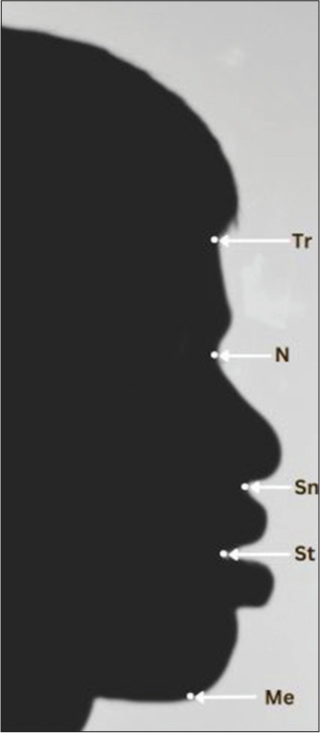
- Silhouette profile photo of Class I bimaxillary protrusion patient with landmarks.
Analyzing the golden proportion in the study, each silhouette profile photograph was marked by five anatomical landmarks as follows [Figure 1]:[5]
Methodology
Tr – Trichion
Me – Soft-tissue menton
Sn – Subnasal
St – Stomion
N – Soft-tissue nasion
R1 and R2 ratio depicts the upper two-thirds of facial height and lower two-thirds of facial height, respectively. R3 represents the ratio between the upper two-third and lower one-third of facial height. Whereas R4 represents the ratio of the lower lip and chin height with a lower one-third of the facial height, and R5 is lower lip and chin height to lower two-thirds of facial height ratio.
After identifying the mentioned landmarks, six linear dimensions and the following proportions were measured respectively:
R1 = Tr to Me: Tr to Sn
R2= Tr to Me: N to Me
R3= Tr to Sn: Sn to Me
R4= Sn to Me: St to Me
R5= N to Sn: St to Me
All these ratios were approximately 1.618:1. These ratios of pre-treatment and post-treatment were then compared to determine the post-treatment effect seen on soft tissues.
Patient Consent: Not applicable in this study as patient anonymity was maintained throughout the study.
To perform statistical investigation, version 21 of SPSS was applied for SPSSInc, Chicago, IL)
Both the mean deviation along with standard deviation were used to express data that were descriptive and continuous
Data normality was evaluated using the Shapiro–Wilk test.
Method of data analysis
Intragroup comparison concerning the response of soft tissues to orthodontic correction of bimaxillary protrusion was done using the Paired t-test.
Operational definitions
Trichion (Tr): It is a higher outline present on the forehead, also known as a hairline
Soft-tissue nasion (N): It is present on a concave most point of the tissue over the suture present between the frontal and nasal bone
Subnasale (Sn): a landmark where the septum of the nose and the starting point of the upper labium
Stomion (St): When both lips are closed, it is the midpoint of the oral embrasure
Soft-tissue menton (Me): It is present inferiorly on the tissues of the mentum.
RESULTS
According to Table 1, females show the ratio changes that occurred after the extraction of the first bicuspid; differences were greatly noticeable (P <0.001) in R1, R2, and R4 ratios, which had pre-treatment mean values of 1.544, 1.615, and 1.463, respectively. On the other hand, R3 (P = 0.02) and R5 (P = 0.047) ratios showed statistically significant differences. In consequence, R1, R2, and R4 ratios obtained were approximately similar to divine proportion which, in turn, can help to decide that the first premolars extraction as a treatment modality helps to achieve aesthetically pleasing facial profiles in females with Class I bimaxillary protrusion.
| Females | Pre Mean (SD) |
Post Mean (SD) |
Paired t-test | P-value, Significance |
|---|---|---|---|---|
| R1 | 1.544 (0.05) | 1.827 (0.119) | t=−10.783 | P<0.001** |
| R2 | 1.615 (0.105) | 1.882 (0.095) | t=−9.394 | P<0.001** |
| R3 | 1.722 (0.18) | 2.221 (1.017) | t=−2.416 | P=0.02* |
| R4 | 1.463 (0.135) | 1.799 (0.199) | t=−6.956 | P<0.001** |
| R5 | 1.017 (0.234) | 1.955 (2.495) | t=−1.871 | P=0.047* |
Table 2 shows a comparison of ratios in males both before and after the treatment, which shows high statistical significance in all proportions (P < 0.001). All the ratios of after-treatment showed changes that caused esthetically pleasant faces in males. This states that first premolar extraction does help to achieve divine proportion in males.
| Males | Pre Mean (SD) |
Post Mean (SD) |
Paired t-test | P-value, Significance |
|---|---|---|---|---|
| R1 | 1.690 (0.101) | 1.986 (0.122) | t=−9.319 | P<0.001** |
| R2 | 1.444 (0.077) | 1.811 (0.121) | t=−12.727 | P<0.001** |
| R3 | 1.357 (0.169) | 1.742 (0.222) | t=−6.883 | P<0.001** |
| R4 | 1.460 (0.102) | 1.792 (0.106) | t=−11.19 | P<0.001** |
| R5 | 0.962 (0.089) | 1.283 (0.131) | t=−10.11 | P<0.001** |
According to Table 3 a comparison between pre-treatment ratios of females and males, R1 and R2 being P = 0.015 and P = 0.007, respectively, shows significance. R3 with P < 0.001 shows high statistical significance. R4) and R5 with P = 0.937 and 0.682, respectively, show insignificance.
| Pre- level | Females Mean (SD) |
Males Mean (SD) |
Paired t-test | P-value, Significance |
|---|---|---|---|---|
| R1 | 1.544 (0.05) | 1.690 (0.101) | t=−3.267 | P=0.015* |
| R2 | 1.615 (0.105) | 1.444 (0.077) | t=5.781 | P=0.007* |
| R3 | 1.722 (0.18) | 1.357 (0.169) | t=9.28 | P<0.001** |
| R4 | 1.463 (0.135) | 1.460 (0.102) | t=0.092 | P=0.937 |
| R5 | 1.017 (0.234) | 0.962 (0.089) | t=1.026 | P=0.682 |
P>0.05: Not significant, *P<0.05: Significant, **P<0.001: Highly statistical significant. SD: Standard deviation
According to Table 4, a comparison between post-treatment proportions of male and female, R1, R2, and R4 shows P = 0.092, 0.672, and 0.927, respectively, showing negligible significance. R3 (P = 0.008) shows significance and R5 (P < 0.001) shows remarkable statistical significance.
| Pre- level | Females Mean (SD) |
Males Mean (SD) |
Paired t-test | P-value, Significance |
|---|---|---|---|---|
| R1 | 1.827 (0.119) | 1.986 (0.122) | t=2.912 | P=0.092 |
| R2 | 1.882 (0.095) | 1.811 (0.121) | t=0.108 | P=0.672 |
| R3 | 2.221 (1.017) | 1.742 (0.222) | t=7.912 | P=0.008* |
| R4 | 1.799 (0.199) | 1.792 (0.106) | t=0.008 | P=0.927 |
| R5 | 1.955 (2.495) | 1.283 (0.131) | t=14.871 | P<0.001** |
P>0.05: Not significant, *P<0.05: Significant, **P<0.001: Highly statistical significant. SD: Standard deviation
DISCUSSION
In recent times, there has been a significant focus on the esthetics aspects of facial harmony and attractiveness, and all forms of facial beauty are being studied by various fields.
It seems that patients undergoing orthodontic treatment are predominantly driven by their own perception of beauty. This indicates that we as clinicians should pay extra attention to esthetic aspect of orthodontic therapy, which includes soft-tissue components such as lip position, chin, and facial convexity while planning the treatment.
Ricketts determined the use of golden proportion in a large number of optimal cephalogram (ceph) X-rays. Therefore, Ricketts suggested the application of these divine proportions to help in the organization of orthognathic surgery.[4] Jefferson has also shown that facial beauty can be associated with the golden proportion, directly.[5] However, there is no study yet that mentioned whether we can achieve divine proportion using lateral cephs, after premolars extraction in bimaxillary protrusion cases or not. In this study, we used both pre-treatment and post-treatment silhouette profile photographs of the patient-derived from lateral cephs. The present study focused on the changes that occurred in tissues as well as teeth in the facial structure of patients with Class I bimaxillary protrusion corrected with premolars extraction.
The key factor in predicting the soft-tissue profile following premolar extraction is the proportion of the amount of retrusion of the lip to retraction of maxillary and mandibular anterior teeth. In Indonesians, Kusnoto and Kusnoto showed that the proportions of retraction of front teeth were 1:0.4 and backward displacement of both lips was 1:0.6. The alterations seen in lips correlated with the upper and lower incisor alterations mostly.[6] In this study, we have found that the pre-treatment mean R4 ratio in females was 1.463, whereas post-treatment was 1.799, while, in males, it was 1.460 and 1.792, respectively. This showed that after premolars extraction, the retracted anterior teeth along with lips caused changes that were approximately the same as divine proportion.
According to a study, the premolars extraction successfully decreases the procumbency of tissues in patients with Sk Class I bimaxillary protrusion. The lower lip and the upper lip were retracted by 2.4 mm and 3 mm, respectively. Whereas, the nasolabial angle remained constant.[7] Similarly, in male and female profiles, the R4 ratio has shown very significant changes. As a consequence, it can result in more pleasant profiles [Graph 1.1 and 1.2].
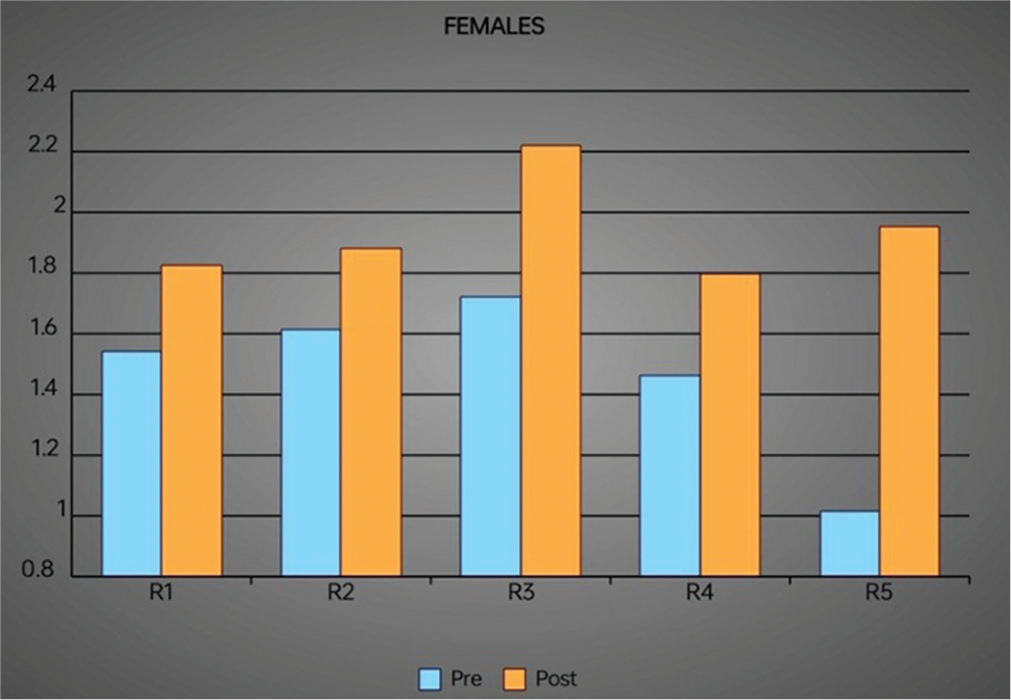
- Comparison of pre and post study parameters in females.
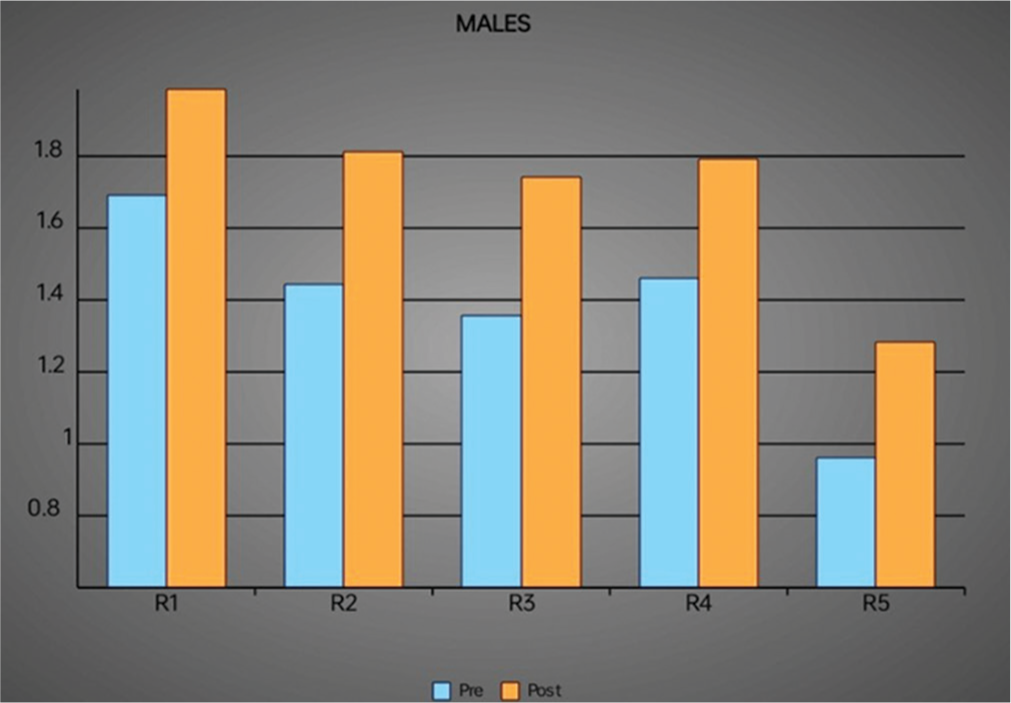
- Comparison of pre and post study parameters in males.
Furthermore, soft-tissue alterations in the nose and chin may result in a significant retrusion of the face. Lateral ceph X-rays of all subjects aged between 18 and 42 years were assessed by Formby et al, and according to him, a noticeable flattening of the face in males noted changes in the nose that showed an increase in proportions as well as in the soft tissues in the bony chin region. Females showed that lips do not appear to be retruded as the width of the tissues in the pogonion region decreases.[8] Similarly, in this study, males showed a statistically significant difference (P <0.001**) [Table 2] in R1, R2, R3, and R5 while females showed a statistically significant difference in only R1 and R2 ratios, R3 (P = 0.02*) [Table 1] and R5 (P = 0.047*) [Table 1] ratio showed a statistically significant difference [Graph 1.1, 1.2, 2.1 and 2.2]. When bimaxillary protrusion cases are treated by retraction of the maxillary and mandibular front teeth the nasolabial angle, along with the labiomental angle increases as the lips lag, this helps the profile to become opisthognathous, which contributes to an aesthetically pleasing face.
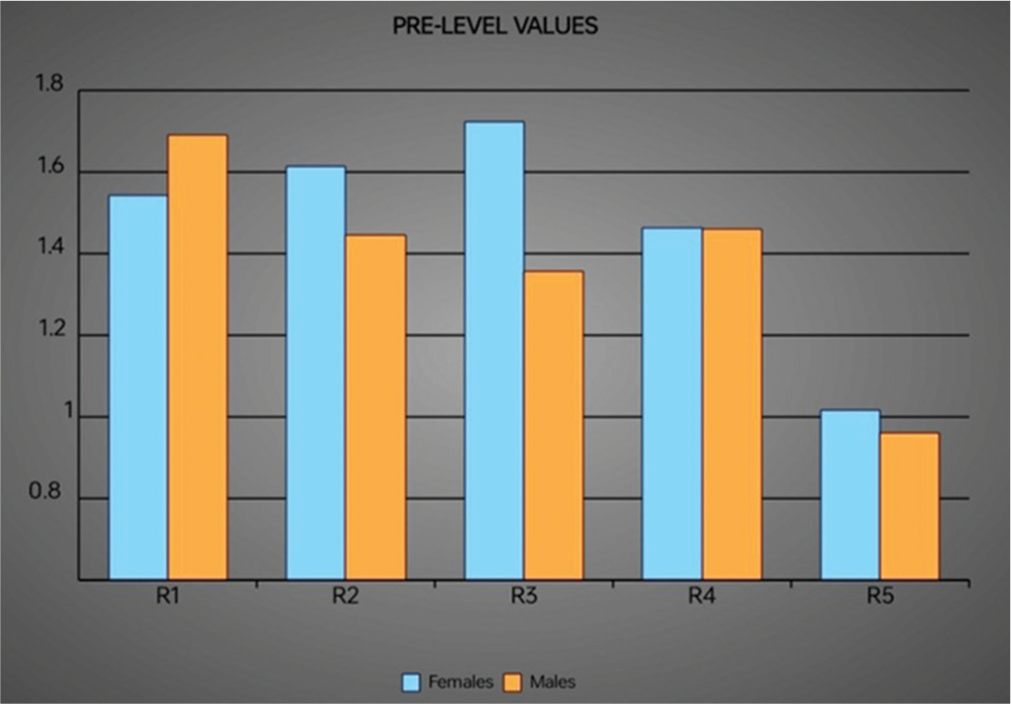
- Comparison of pre study parameters in males and females.
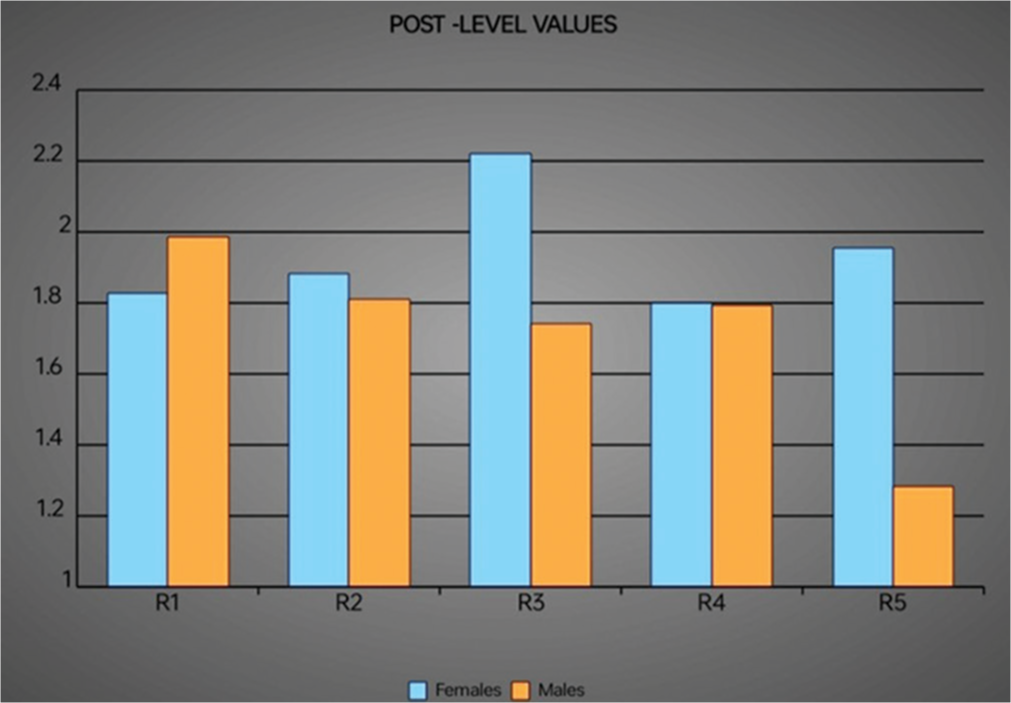
- Comparison of post study parameters in males and females.
According to Jahanbin A, Basafa M, Alizadeh Y, in individuals having greater aesthetics, trichion- soft tissue menton : trichionsubnasale and trichion- soft tissue menton: soft tissue nasion-soft tissue menton ratios showed value of 1.58 which was closer to divine ratio i.e. 1.618. Thus these are the most important proportions in evaluation of aesthetics of the profile.[9]
Moreover, previous studies concluded, appreciably good looking individuals showed a concurrence of 73.33% with rules of aesthetics, and it also included divine proportion. While the less good looking individuals showed a concurrence of only 38.33%. Since the patients with skeletal class I bimaxillary protrusion suggest facial aesthetic imbalance, this study did not judge patients’ attractiveness.[10-12]
Taking previous studies into consideration, this study focused on the profile of patients treated by orthodontic premolar extractions. This study helped to establish a positive connection between divine proportion and premolars extraction as a treatment modality for Sk Class II patients. This signifies that by extracting the first premolars, we are able to achieve results closer to divine proportion, which directly impacts the perception of facial beauty.
Thus, the divine ratio could be used in the planning of treatment as a guide to achieve satisfactory results. The application of the divine ratio in assessing the profile of a patient will enhance orthodontic treatment in achieving good esthetics of the facial structure, and this would also help the orthodontists to meet the patient’s expectations, thus leading to a higher level of patient satisfaction.
This study did not take into account the growth pattern of the patients. Further studies need to be undertaken to study the correlation between divine proportion and premolar extraction in patients with different growth patterns.
CONCLUSION
Considering all the limitations of facial proportion research, the following interpretation can be drawn:
All post-treatment ratios in males and R1, R2 and R4 in females were found to be closer to divine proportion.
Extraction of bicuspids in Sk Class I bimaxillary protrusion cases does help to achieve results closer to divine proportion; this, in turn, helps us to achieve aesthetically pleasant facial profiles in Sk Class I bimaxillary protrusion cases.
Acknowledgment
Management Trustee Dr. Pradeep GL, Principal Dr. Pradeep GL of MGV’s KBH Dental College and Hospital.
Ethical approval
The research/study approved by the Institutional Review Board at MGV’S KBH Dental College and Hospital, number MGV/KBHDC/1069/2023-24, dated 21st January 2023.
Declaration of patient consent
Patient’s consent not required as patients identity is not disclosed or compromised.
Conflicts of interest
There are no conflicts of interest.
Use of artificial intelligence (AI)-assisted technology for manuscript preparation
The authors confirm that there was no use of artificial intelligence (AI)-assisted technology for assisting in the writing or editing of the manuscript and no images were manipulated using AI.
Financial support and sponsorship
Nil.
References
- LFH and soft tissue changes in BI-JAW protrusion cases. Sci Dent J. 2019;3:1-7.
- [CrossRef] [Google Scholar]
- Assessment of divine proportion in the cranial structure of individuals with Angle Class II malocclusion on lateral cephalograms. Dent Press J Orthod. 2012;17:88-97.
- [CrossRef] [Google Scholar]
- The biologic significance of the divine proportion and Fibonacci series. Am J Orthod. 1982;81:351-70.
- [CrossRef] [PubMed] [Google Scholar]
- Divine proportion in facial esthetics. Clin Plast Surg. 1982;9:401-22.
- [CrossRef] [PubMed] [Google Scholar]
- Facial beauty--establishing a universal standard. Int J Orthod Milwaukee. 2004;15:9-22.
- [Google Scholar]
- The effect of anterior tooth retraction on lip position of orthodontically treated adult Indonesians. Am J Orthod Dentofacial Orthop. 2001;120:304-7.
- [CrossRef] [PubMed] [Google Scholar]
- Bimaxillary dentoalveolar protrusion: Traits and orthodontic correction. Angle Orthod. 2005;75:333-9.
- [Google Scholar]
- Longitudinal changes in the adult facial profile. Am J Orthod Dentofacial Orthop. 1994;105:464-76.
- [CrossRef] [PubMed] [Google Scholar]
- Evaluation of the divine proportion in the facial profile of young females. Indian J Dent Res. 2008;19:292-6.
- [CrossRef] [PubMed] [Google Scholar]
- Haptic aesthetic value of the golden section. Br J Psychol. 1971;62:217-23.
- [CrossRef] [PubMed] [Google Scholar]
- Construtores de sorriso-ciência ou arte. 2003. APCD São José do Rio Preto. Available from: https://www.apcdriopreto.com.br/artigos2.asp
- [Google Scholar]
- The golden section: The “true” ratio? Percept Mot Skills. 1978;46:831-4.
- [CrossRef] [PubMed] [Google Scholar]






